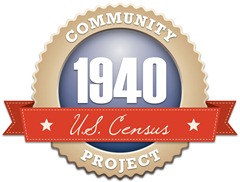 There is much excitement over the upcoming release of the 1940 census. Genealogists are blessed with another resource, while the average person is intrigued by the prospect of finding their parents, grandparents, or themselves, in the 1940 census.
There is much excitement over the upcoming release of the 1940 census. Genealogists are blessed with another resource, while the average person is intrigued by the prospect of finding their parents, grandparents, or themselves, in the 1940 census.
The 1940 census is practically two censuses in one. Not only does it provide clues for family living in 1940, it also provides clues for the time period between 1930 and 1940. How is that possible? Well, one of the questions asks where each person lived in 1935. This can narrow the range for when births and immigrations occurred. For example, if a child was reported with a residence in 1935, then the chance that they were born before 1935 is very probable (of course census reporting isn’t perfect, so never assume). Another example is, if the 1935 residence for a person is foreign, then they probably immigrated to the US between 1935 and 1940.
Another important piece of the 1940 census is a notation of who provided the information. In the past, we’ve had to speculate who might have provided the household’s information, never knowing for sure if it was a household member or a neighbor. Now we’ll know, which can help us better evaluate the information.
While the census images will be released to the public on April 2, the challenge will be finding volunteers to begin indexing the 132 million people who were enumerated, to make it easier for everyone to find their family. One such indexing project is through FamilySearch, who has partnered with brightsolid and Archives.com.
The following websites provide additional information on the census itself, fun facts, and indexing information. Be sure to check out the blank 1940 census form to see the complete list of questions and familiarize yourself with the form.
- 1940 US Census Project (FamilySearch)
- 1940 Census (Find My Past / brightsolid)
- US Census 1940 (Archives.com)
- 1940 Federal Population Census (NARA)
- Blank 1940 US Census Form

Looking forward to the day!
FamilySearch has an easy-to-use interface for doing volunteer data entry–a wonderful chance to “give back” for all that kind-soul genealogy help we’ve all been the recipients of over the years.